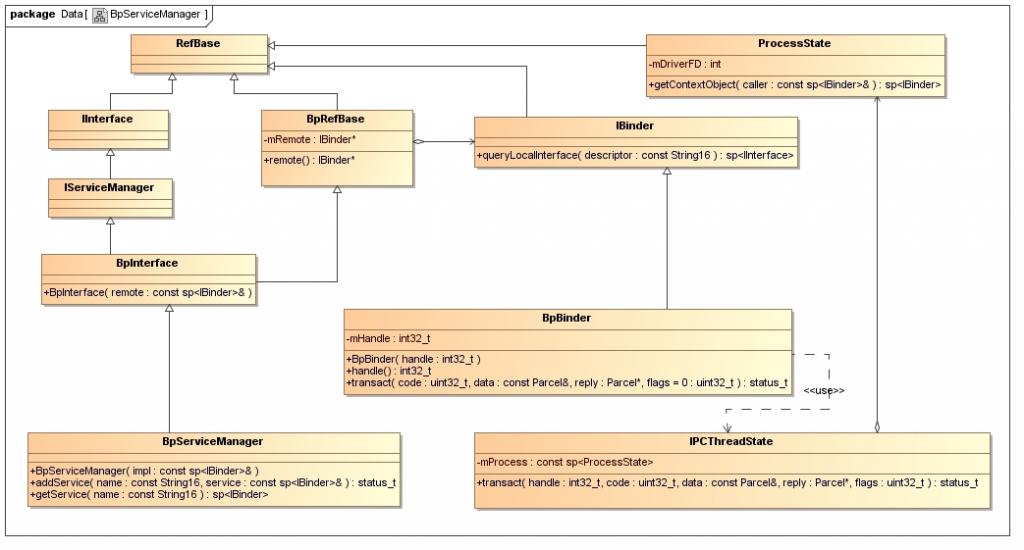在阅读本文之前,希望读者先阅读Android进程间通信(IPC)机制Binder简要介绍和学习计划一文提到的参考资料Android深入浅出之Binder机制,这样可以加深对本文的理解。
我们知道,Service Manager在Binder机制中既充当守护进程的角色,同时它也充当着Server角色,然而它又与一般的Server不一样。对于普通的Server来说,Client如果想要获得Server的远程接口,那么必须通过Service Manager远程接口提供的getService接口来获得,这本身就是一个使用Binder机制来进行进程间通信的过程。而对于Service Manager这个Server来说,Client如果想要获得Service Manager远程接口,却不必通过进程间通信机制来获得,因为Service Manager远程接口是一个特殊的Binder引用,它的引用句柄一定是0。
获取Service Manager远程接口的函数是defaultServiceManager,这个函数声明在frameworks/base/include/binder/IServiceManager.h文件中:
- sp<IServiceManager> defaultServiceManager();
实现在frameworks/base/libs/binder/IServiceManager.cpp文件中:
- sp<IServiceManager> defaultServiceManager()
- {
- if (gDefaultServiceManager != NULL) return gDefaultServiceManager;
- {
- AutoMutex _l(gDefaultServiceManagerLock);
- if (gDefaultServiceManager == NULL) {
- gDefaultServiceManager = interface_cast<IServiceManager>(
- ProcessState::self()->getContextObject(NULL));
- }
- }
- return gDefaultServiceManager;
- }
- Mutex gDefaultServiceManagerLock;
- sp<IServiceManager> gDefaultServiceManager;
在继续介绍interface_cast<IServiceManager>(ProcessState::self()->getContextObject(NULL))的实现之前,先来看一个类图,这能够帮助我们了解Service Manager远程接口的创建过程。

参考资料Android深入浅出之Binder机制一文的读者,应该会比较容易理解这个图。这个图表明了,BpServiceManager类继承了BpInterface<IServiceManager>类,BpInterface是一个模板类,它定义在frameworks/base/include/binder/IInterface.h文件中:
- template<typename INTERFACE>
- class BpInterface : public INTERFACE, public BpRefBase
- {
- public:
- BpInterface(const sp<IBinder>& remote);
- protected:
- virtual IBinder* onAsBinder();
- };
理解了这些概念之后,就可以继续分析创建Service Manager远程接口的过程了,最终目的是要创建一个BpServiceManager实例,并且返回它的IServiceManager接口。创建Service Manager远程接口主要是下面语句:
- gDefaultServiceManager = interface_cast<IServiceManager>(
- ProcessState::self()->getContextObject(NULL));
首先是调用ProcessState::self函数,self函数是ProcessState的静态成员函数,它的作用是返回一个全局唯一的ProcessState实例变量,就是单例模式了,这个变量名为gProcess。如果gProcess尚未创建,就会执行创建操作,在ProcessState的构造函数中,会通过open文件操作函数打开设备文件/dev/binder,并且返回来的设备文件描述符保存在成员变量mDriverFD中。
接着调用gProcess->getContextObject函数来获得一个句柄值为0的Binder引用,即BpBinder了,于是创建Service Manager远程接口的语句可以简化为:
- gDefaultServiceManager = interface_cast<IServiceManager>(new BpBinder(0));
- template<typename INTERFACE>
- inline sp<INTERFACE> interface_cast(const sp<IBinder>& obj)
- {
- return INTERFACE::asInterface(obj);
- }
- DECLARE_META_INTERFACE(ServiceManager);
展开即为:
- #define DECLARE_META_INTERFACE(ServiceManager) \
- static const android::String16 descriptor; \
- static android::sp<IServiceManager> asInterface( \
- const android::sp<android::IBinder>& obj); \
- virtual const android::String16& getInterfaceDescriptor() const; \
- IServiceManager(); \
- virtual ~IServiceManager();
IServiceManager::asInterface的实现是通过IMPLEMENT_META_INTERFACE(ServiceManager, "android.os.IServiceManager")宏定义的,它位于framework/base/libs/binder/IServiceManager.cpp文件中:
- IMPLEMENT_META_INTERFACE(ServiceManager, "android.os.IServiceManager");
- #define IMPLEMENT_META_INTERFACE(ServiceManager, "android.os.IServiceManager") \
- const android::String16 IServiceManager::descriptor("android.os.IServiceManager"); \
- const android::String16& \
- IServiceManager::getInterfaceDescriptor() const { \
- return IServiceManager::descriptor; \
- } \
- android::sp<IServiceManager> IServiceManager::asInterface( \
- const android::sp<android::IBinder>& obj) \
- { \
- android::sp<IServiceManager> intr; \
- if (obj != NULL) { \
- intr = static_cast<IServiceManager*>( \
- obj->queryLocalInterface( \
- IServiceManager::descriptor).get()); \
- if (intr == NULL) { \
- intr = new BpServiceManager(obj); \
- } \
- } \
- return intr; \
- } \
- IServiceManager::IServiceManager() { } \
- IServiceManager::~IServiceManager() { }
- android::sp<IServiceManager> IServiceManager::asInterface(const android::sp<android::IBinder>& obj)
- {
- android::sp<IServiceManager> intr;
- if (obj != NULL) {
- intr = static_cast<IServiceManager*>(
- obj->queryLocalInterface(IServiceManager::descriptor).get());
- if (intr == NULL) {
- intr = new BpServiceManager(obj);
- }
- }
- return intr;
- }
- sp<IInterface> IBinder::queryLocalInterface(const String16& descriptor)
- {
- return NULL;
- }
- intr = new BpServiceManager(obj);
- intr = new BpServiceManager(new BpBinder(0));
- gDefaultServiceManager = new BpServiceManager(new BpBinder(0));
在Android系统的Binder机制中,Server和Client拿到这个Service Manager远程接口之后怎么用呢?
对Server来说,就是调用IServiceManager::addService这个接口来和Binder驱动程序交互了,即调用BpServiceManager::addService 。而BpServiceManager::addService又会调用通过其基类BpRefBase的成员函数remote获得原先创建的BpBinder实例,接着调用BpBinder::transact成员函数。在BpBinder::transact函数中,又会调用IPCThreadState::transact成员函数,这里就是最终与Binder驱动程序交互的地方了。回忆一下前面的类图,IPCThreadState有一个PorcessState类型的成中变量mProcess,而mProcess有一个成员变量mDriverFD,它是设备文件/dev/binder的打开文件描述符,因此,IPCThreadState就相当于间接在拥有了设备文件/dev/binder的打开文件描述符,于是,便可以与Binder驱动程序交互了。
对Client来说,就是调用IServiceManager::getService这个接口来和Binder驱动程序交互了。具体过程上述Server使用Service Manager的方法是一样的,这里就不再累述了。
IServiceManager::addService和IServiceManager::getService这两个函数的具体实现,在下面两篇文章中,会深入到Binder驱动程序这一层,进行详细的源代码分析,以便更好地理解Binder进程间通信机制,敬请关注。






















 394
394

 被折叠的 条评论
为什么被折叠?
被折叠的 条评论
为什么被折叠?








